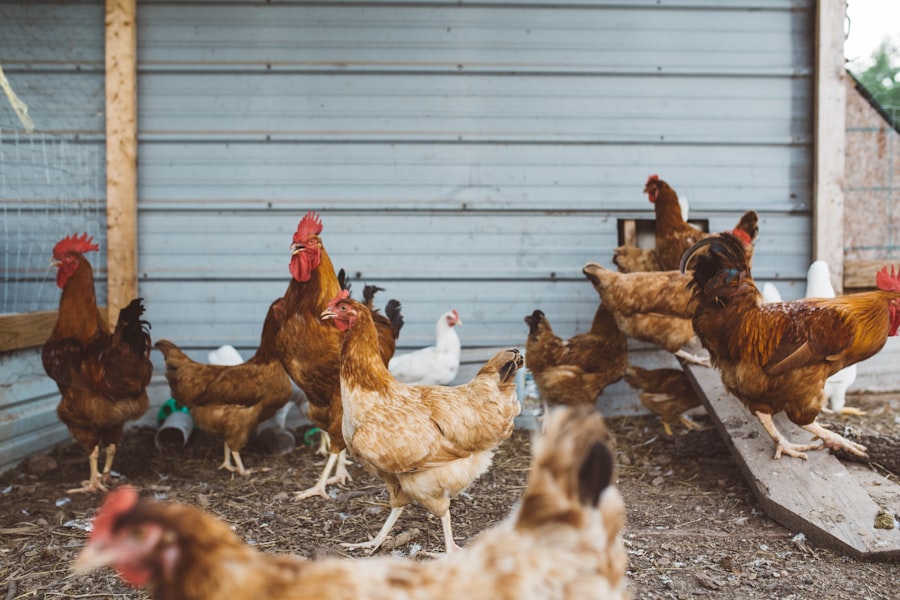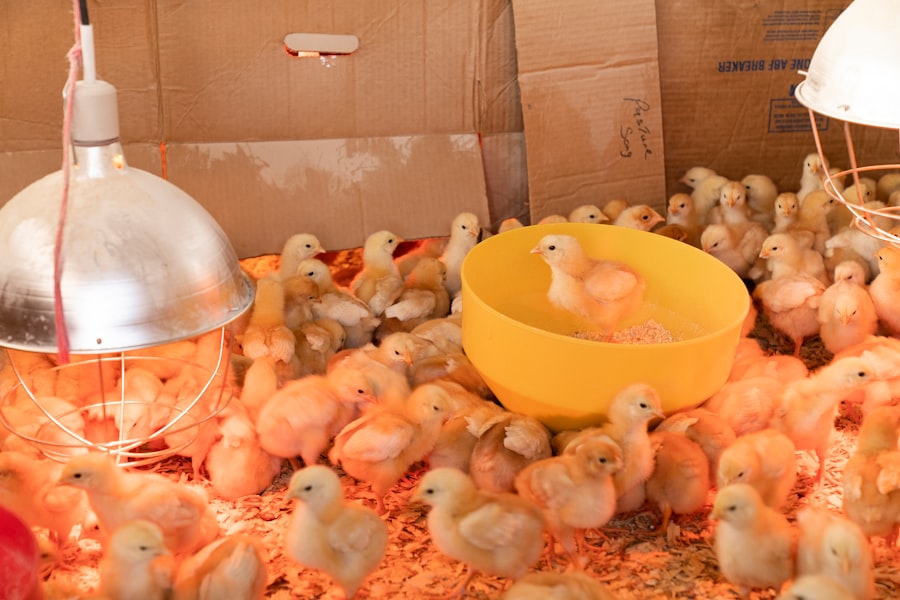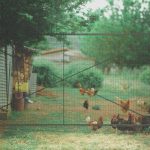Wing clipping is an essential practice in poultry management, particularly for backyard chicken keepers. This humane procedure effectively prevents chickens from flying over fences and escaping their designated areas, ensuring their safety and protecting neighboring properties. Unrestrained chickens can damage gardens, flower beds, and other property, and may face risks of injury or becoming lost in unfamiliar surroundings.
By clipping their wings, owners can keep chickens secure within their intended space. Additionally, wing clipping can help mitigate aggressive behavior in roosters. Flight-capable roosters may exhibit increased territorial and aggressive tendencies, potentially endangering humans and other chickens.
Limiting their ability to fly can reduce the likelihood of such behavior. Understanding the importance of wing clipping is crucial for maintaining chicken safety, well-being, and a harmonious environment for both chickens and their caretakers.
Table of Contents
- 1 Gathering the necessary tools and supplies
- 2 Preparing the chicken for wing clipping
- 3 Identifying and clipping the primary flight feathers
- 4 Ensuring proper care and handling during the process
- 5 Monitoring and managing regrowth of feathers
- 6 Considering alternative methods for preventing flight
- 7 FAQs
- 7.1 What is the purpose of clipping a chicken’s wings?
- 7.2 At what age should you start clipping a chicken’s wings?
- 7.3 How often should you clip a chicken’s wings?
- 7.4 Is it painful for the chicken to have its wings clipped?
- 7.5 What tools do you need to clip a chicken’s wings?
- 7.6 How do you clip a chicken’s wings?
- 7.7 Are there any risks or complications associated with clipping a chicken’s wings?
Key Takeaways
- Clipping chicken wings is important to prevent them from flying away and getting lost or injured
- Necessary tools and supplies include sharp scissors, a towel, and a helper if possible
- Before clipping, gently restrain the chicken and cover its head to keep it calm
- Identify and clip the primary flight feathers on one wing, being careful not to cut too close to the skin
- Proper care and handling during the process includes keeping the chicken calm and providing treats afterwards
- Monitor regrowth of feathers and repeat the clipping process as needed
- Alternative methods for preventing flight include using chicken harnesses or building higher fences
Gathering the necessary tools and supplies
Primary Tools and Equipment
The primary tool needed for wing clipping is a pair of sharp, clean scissors or poultry shears. It’s crucial to use sharp scissors to ensure a clean cut and minimize any discomfort or injury to the chicken.
Additional Supplies for a Safe Process
Additionally, having a towel or blanket on hand can help to safely and securely restrain the chicken during the wing clipping process. This will help to prevent any unnecessary stress or movement that could lead to accidental injury. It’s also important to have a first aid kit nearby in case of any accidents or injuries during the wing clipping process.
First Aid Kit Essentials and Additional Assistance
The first aid kit should include items such as antiseptic solution, bandages, and styptic powder to stop any bleeding that may occur. Lastly, having a second person present to assist with holding the chicken can be beneficial, especially for those who are new to wing clipping. With the necessary tools and supplies gathered, one can proceed with confidence in preparing the chicken for wing clipping.
Preparing the chicken for wing clipping

Before beginning the wing clipping process, it is important to prepare the chicken and create a calm and controlled environment. Start by gently catching the chicken and wrapping it in a towel or blanket to help keep it calm and secure. This will also help to prevent any sudden movements that could lead to injury during the wing clipping process.
It is important to handle the chicken with care and gentleness to minimize stress and discomfort. Once the chicken is securely wrapped, it is important to find a quiet and well-lit area for the wing clipping process. This will help to ensure that the person performing the wing clipping can see clearly and make precise cuts without causing unnecessary harm to the chicken.
Additionally, having a second person present to assist with holding the chicken can help to further ensure a safe and controlled environment for the wing clipping process. By taking these preparatory steps, one can help to minimize stress and discomfort for the chicken while also ensuring a safe and effective wing clipping experience.
Identifying and clipping the primary flight feathers
When it comes to clipping a chicken’s wings, it is important to focus on trimming the primary flight feathers, also known as the primary remiges. These are the long feathers located at the end of the wing that provide lift during flight. By trimming these feathers, it limits the chicken’s ability to achieve lift and fly over fences or other barriers.
To identify these primary flight feathers, gently extend the chicken’s wing and look for the longest feathers at the tip of the wing. Once these feathers are identified, it is important to trim them carefully and precisely. Using sharp scissors or poultry shears, make clean cuts about halfway down the length of the primary flight feathers.
It is crucial to avoid cutting too close to the base of the feather, as this can cause discomfort or injury to the chicken. Additionally, it is important to trim both wings evenly to maintain balance and prevent any potential flight capabilities. By focusing on identifying and clipping the primary flight feathers with precision and care, one can effectively limit the chicken’s ability to fly while also ensuring their comfort and well-being.
Ensuring proper care and handling during the process
During the wing clipping process, it is crucial to ensure proper care and handling of the chicken to minimize stress and discomfort. It is important to handle the chicken with gentleness and patience, as sudden movements or rough handling can cause unnecessary stress and potential injury. Wrapping the chicken in a towel or blanket can help to keep it calm and secure while also preventing any sudden movements that could lead to accidents.
Additionally, it is important to monitor the chicken’s behavior throughout the wing clipping process. Look for signs of distress or discomfort, such as vocalization or struggling, and adjust handling as needed to ensure their well-being. Having a second person present to assist with holding the chicken can also help to ensure a safe and controlled environment for wing clipping.
By prioritizing proper care and handling during the process, one can help to minimize stress and discomfort for the chicken while also ensuring a safe and effective wing clipping experience.
Monitoring and managing regrowth of feathers

Monitoring Regrowth of Feathers
After clipping a chicken’s wings, it is crucial to monitor and manage the regrowth of feathers to maintain their flight limitations. The primary flight feathers will eventually grow back over time, so it is essential to regularly check for regrowth and trim them as needed. This will help to ensure that the chicken’s ability to fly remains limited and that they stay safe within their designated area.
Identifying and Trimming Regrowth
When monitoring regrowth, it is important to look for new feathers growing in at the same location where they were previously trimmed. Once regrowth is identified, carefully trim these new feathers with sharp scissors or poultry shears as needed.
Regular Maintenance for Effective Flight Limitation
It is important to continue monitoring and managing regrowth regularly to maintain flight limitations effectively. By staying proactive in monitoring and managing regrowth of feathers, one can help to ensure that the chicken remains safe and secure within their designated space.
Considering alternative methods for preventing flight
While wing clipping is a common method for preventing chickens from flying, there are alternative methods that can also be considered. One alternative method is using poultry netting or fencing with a cover over the top of the enclosure to prevent chickens from flying out. This provides a more natural environment for chickens while still keeping them contained within their designated area.
Another alternative method is providing enrichment activities within their designated space to keep them occupied and less likely to attempt flying out. This can include providing perches, dust baths, and other stimulating activities that encourage natural behaviors while keeping them grounded. Additionally, providing adequate space and environmental enrichment can help reduce stress and prevent chickens from attempting to escape.
It is important to consider these alternative methods in conjunction with wing clipping to provide a comprehensive approach to preventing flight in chickens. By exploring alternative methods for preventing flight, one can create a safe and enriching environment for chickens while also maintaining effective containment within their designated space. In conclusion, understanding the need to clip chicken wings is essential for maintaining a safe and secure environment for backyard chickens.
By gathering the necessary tools and supplies, preparing the chicken for wing clipping, identifying and clipping the primary flight feathers with precision, ensuring proper care and handling during the process, monitoring and managing regrowth of feathers, and considering alternative methods for preventing flight, one can effectively limit a chicken’s ability to fly while also ensuring their comfort and well-being. With proper knowledge and attention to detail, wing clipping can be performed safely and effectively as part of responsible poultry management.
If you’re looking for more tips on keeping your chickens safe and secure, check out this article on where to put a chicken coop. It’s important to have a well-placed coop to ensure your chickens are protected from predators and the elements. And while you’re at it, you might also want to consider adding a heater for your chicken coop and a nest box to make sure your chickens are comfortable and happy.
FAQs
What is the purpose of clipping a chicken’s wings?
Clipping a chicken’s wings is done to prevent them from flying and escaping from their enclosure. It helps to keep them safe and contained within a specific area.
At what age should you start clipping a chicken’s wings?
It is recommended to start clipping a chicken’s wings when they are around 10-12 weeks old, as this is when their flight feathers start to grow in.
How often should you clip a chicken’s wings?
Wings should be clipped about once a year, as the feathers will grow back after molting. However, some chickens may need more frequent clipping if their feathers grow back quickly.
Is it painful for the chicken to have its wings clipped?
Clipping a chicken’s wings is not painful, as it only involves trimming the flight feathers. It is similar to trimming human nails and does not cause any harm to the chicken.
What tools do you need to clip a chicken’s wings?
To clip a chicken’s wings, you will need a pair of sharp scissors or poultry shears to trim the flight feathers. It is also helpful to have someone to hold the chicken while you trim its wings.
How do you clip a chicken’s wings?
To clip a chicken’s wings, you will need to trim the primary flight feathers on one wing, cutting them to about halfway down the length of the wing. It is important to avoid cutting any blood feathers, as this can cause bleeding and discomfort for the chicken.
Are there any risks or complications associated with clipping a chicken’s wings?
When done properly, clipping a chicken’s wings is a safe and straightforward procedure. However, if the feathers are cut too short or if blood feathers are accidentally cut, it can cause bleeding and discomfort for the chicken. It is important to be cautious and attentive when clipping a chicken’s wings.
Meet Walter, the feathered-friend fanatic of Florida! Nestled in the sunshine state, Walter struts through life with his feathered companions, clucking his way to happiness. With a coop that’s fancier than a five-star hotel, he’s the Don Juan of the chicken world. When he’s not teaching his hens to do the cha-cha, you’ll find him in a heated debate with his prized rooster, Sir Clucks-a-Lot. Walter’s poultry passion is no yolk; he’s the sunny-side-up guy you never knew you needed in your flock of friends!







